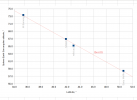Hi all,.
We're running a worldwide Eratosthenes stick experiment on the Reddit sub r/flatearth. This is the experiment where you measure the shadow of a stick at local noon, and compare with other places in the world, and derive the size & shape of the earth.
Details here:
Source: https://www.reddit.com/r/flatearth/comments/n8lm9l/worldwide_eratosthenes_stick_experiment_may_14_15/?utm_source=share&utm_medium=web2x&context=3
We're running a worldwide Eratosthenes stick experiment on the Reddit sub r/flatearth. This is the experiment where you measure the shadow of a stick at local noon, and compare with other places in the world, and derive the size & shape of the earth.
Details here:
Source: https://www.reddit.com/r/flatearth/comments/n8lm9l/worldwide_eratosthenes_stick_experiment_may_14_15/?utm_source=share&utm_medium=web2x&context=3

